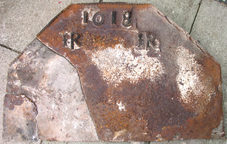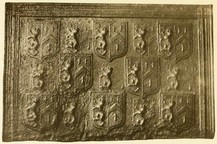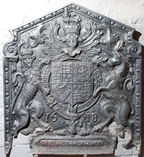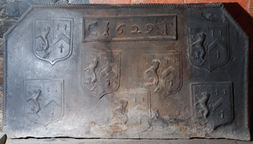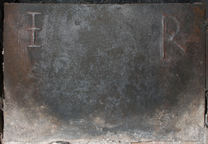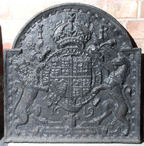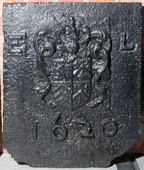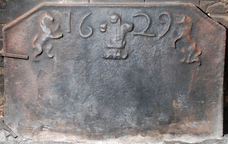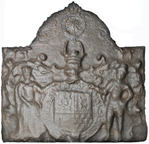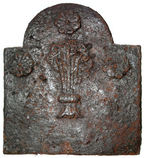-
811
Description: Canted rectangle; twisted rope edging (top and canting only); centre top, date (written as 1018); below to left and right, initials.
Notes: It has been suggested that the initials IR relate to King James I but the lack of any other royal decoration makes this unlikely.
Inscription: 1618 / IR IR
- Decoration tags:
- rectangular with canted top corners (shape)
- rope (edging)
- individual letters
- individual numbers
- text
Manufactured: in 1618 possibly in the Shropshire area of England.
Current location: 50, Church Street, Broseley, Shropshire, England.
- Attached to series:
- Date & initials firebacks
-
202
Description: Rectangular; edging formed from furniture moulding; shield of Ayloffe impaling Sulyard impressed weakly seven times (2-3-2), with the same shield impressed eight times (3-2-3), more deeply, in the spaces between the first shields.
Notes: William Ayloffe (c1535-1584) of Bretons, Hornchurch, Essex, Justice of the Court of Queen’s Bench, married (c1560) Jane, dau. of Sir Eustace Sulyard, of Runwell, Essex. A large number of variants use the same shields. Several copies are known of this fireback, but in precisely the same arrangement, all poorly cast, unlike the variants without the additional shields, which are found in many different arrangements, some with dates and initials. From an illustration in the catalogue of an exhibition on heraldry at Burlington House, London, in 1894, it then being at Manor Farm, Edenbridge, Kent.
Copies of this fireback are known.
Arms: Ayloffe impaling Sulyard (William Ayloffe of Bretons, Hornchurch)
- Decoration tags:
- rectangular (shape)
- complex, furniture-derived (edging)
- carved stamps
- heraldic
- armorial
Manufactured: in the early-17th century in the Weald area of England.
Current location: not known.
- Attached to series:
- Ayloffe series
- Personal armorial firebacks
-
28
Description: Rectangular with pediment raised on inverted consoles; ovolo, egg and dart edging; shield, garter, helm, mantling, crest and motto of the English House of Stuart; date split either side of garter buckle.
Notes: One of several firebacks, all of the same date, but varying in size, framing style and moulding; all have stylistic features in common and will have been the work of the same pattern maker, who was also responsible for carving royal coats of arms in three West Country churches.
Copies of this fireback are known.
Inscription: HONY SOIT QVI MAL Y PENSE / 16 18 / DIEV ET MON DROIT
Arms: English Stuart royal (James I)
- Decoration tags:
- rectangular with detached pediment (shape)
- ovolo, egg and dart (edging)
- whole carved pattern
- armorial
- royal
- text
Manufactured: in 1618 possibly in the Forest of Dean area of England.
Current location: Bateman's, Burwash, East Sussex, England.
Museum number: 761132 (part of the National Trust museum group)
-
30
Description: Rectangular, with canted top corners; twisted rope edging on top and sides; cavetto-moulded-edged rectangle top centre, enclosing date between initials; seven shields of Ayloffe impaling Sulyard; Ayloffe: sable, a lion rampant Or, collared gules, between three crosses formy of the second; Sulyard: argent, a chevron gules between three pheons inverted sable.
Notes: William Ayloffe (c.1535-1584) of Bretons, Hornchurch, Essex, Justice of the Court of Queen’s Bench, married (c1560) Jane, dau. of Sir Eustace Sulyard, of Runwell, Essex. A large number of variants use the same shields. The possibility that 'CT' was the founder Charles Tyler (d.1629/30) is reinforced by the fact that Poundsford Farm, Burwash, was owned by his grandson, also Charles, and subsequently by the latter's widow, Mary. The back was first noted at Poundsford in 1869.
Inscription: C 1629 T
Arms: Ayloffe impaling Sulyard (William Ayloffe of Bretons, Hornchurch)
- Decoration tags:
- rectangular with canted top corners (shape)
- rope (edging)
- carved stamps
- individual letters
- individual numbers
- planklines
- armorial
- text
Manufactured: in 1629 possibly at Hawkhurst Furnace in the Weald area of England.
Current location: Poundsford Farm, Burwash, East Sussex, England.
Citation: Gardner, J. S., 1898, 'Iron Casting in the Weald', Archaeologia, 56, 1, pp. 133-164.
- Attached to series:
- Ayloffe series
- Personal armorial firebacks
-
221
Description: Rectangular; plain plate; inscription in capitals split between top corners, ‘I’ crossed.
Notes: The letters are likely to have been formed by tracing their shape in the casting sand using a pointed implement.
Inscription: I R
- Decoration tags:
- rectangular (shape)
- none (edging)
- individual letters
- text
Manufactured: in the early-17th century in the Weald area of England.
Current location: in private hands, Buxted, East Sussex, England.
- Attached to series:
- Initials only firebacks
-
229
Description: Rectangular with superimposed arch; embattled, cavetto moulded edging, with the top edge of the rectangle interrupted; shield, garter, crown, supporters and motto of the English Royal house of Stuart; rose and thistle plants above lion and unicorn supporters respectively; initials split by crown; date below garter.
Notes: An example in the Musée d'Agen in France is illustrated by Carpentier (1912, p.419). A different version is at Newick Park, Sussex (no. 502).
Copies of this fireback are known.
Inscription: I R / HONI S OIT QVI MAL Y ..ENSE / 16 19
Arms: English Stuart royal
- Decoration tags:
- rectangular with round arch (shape)
- embattled cavetto (edging)
- whole carved pattern
- armorial
- royal
- text
Manufactured: in 1619 in England.
Current location: National History Museum, St Fagans, Glamorgan, Wales.
Museum number: 48.354/85 (part of the Welsh National History Museum museum group)
Citation: Carpentier, H., 1912, Plaques de Cheminées (Paris, published by the author).
-
232
Description: Rectangular shape with bottom corners missing; no edging; central shield, helm, crest and mantling of the Lewis family: quarterly 1st, sable a lion rampant argent (Lewis of Y Fan), 2nd, sable a chevron between three fleurs de lys or (Einon ap Collwyn), 3rd gules three chevronels argent(Iestyn ap Gwrgan), 4th, sable a chevron between three spear heads argent embrued gules (Bleddyn ap Maenyrch); initials split by armorial stamp (’E’ over-stamped); date, formed from single numerals, below arms.
Notes: The arms are those of Sir Edward Lewis, of Van, who purchased St Fagans Castle in 1616. The same armorial stamp was used to model the arms on a lead cistern outside the front door of the castle. It is possible that this fireback was cut down from a larger fireback.
Inscription: E L 1620
Arms: Sir Edward Lewis of Van
- Decoration tags:
- rectangular (shape)
- none (edging)
- carved stamps
- individual letters
- individual numbers
- armorial
- text
Manufactured: in 1620 in the South Wales area of Wales.
Current location: National History Museum, St Fagans, Glamorgan, Wales.
Museum number: 48.354/84 (part of the Welsh National History Museum museum group)
- Attached to series:
- Personal armorial firebacks
- Welsh armorial firebacks
- Bristol armorial series
-
244
Description: Canted rectangle; twisted rope edging (top and sides); stamp of three ostrich feathers within a coronet, between the two parts of the date, with lion and unicorn supporters outside date.
Notes: The ostrich feathers are the badge of the Prince of Wales. There is no known significance of the year 1629 with that title, the birth of the prince (later Charles II) being in the following year. The date was probably added to a recasting of the plate. The lack of detail in the modelling indicates this has been recast several times.
Copies of this fireback are known.
Inscription: 16 29
- Decoration tags:
- rectangular with canted top corners (shape)
- rope (edging)
- carved stamps
- individual numbers
- heraldic
- text
- animals
Manufactured: in 1629 in the Weald area of England.
Current location: in private hands, Chailey, East Sussex, England.
Citation: Lloyd, N., 1925, 'Domestic Ironwork I', Architectural Review, 58, pp. 58-67.
- Attached to series:
- Prince of Wales' feathers series
- Prince of Wales firebacks
-
1259
Description: Plain rectangular plate; shield, garter, helm, mantling and supporters of the Blount family, Lords Mountjoy; above, a Garter enclosing a sun charged with an eye, all surmounted by an earl's coronet; decorative edging of the arch in low relief.
Notes: The arms are those of Charles Blount, 8th Baron Mountjoy (1563-1606), who was invested Knight of the Garter in 1597. He was created 1st Earl of Devonshire in 1603 and the original fireback, of which this is probably a copy, therefore dates from between 1603 and 1606. Blazon: 1. (Blount) Barry nebuly of six Or and Sable; 2. (Ayala) Argent, two wolves passant Sable on a bordure of the first eight saltires Gules; 3. (Mountjoy) Or a tower Azure; 4. (Gresley) Vair. The fireback was made by taking a worn casting of the Mountjoy arms (for a clearer example see no. 740) and using it as a pattern, adding an extension above with the decorative edging and the crowned Garter and sun, the detail of which is sharper than the armorial below. The Garter and sun as a badge of Charles Blount has been noted on two contemporary book bindings. The fireback may have come from Dedisham Manor in West Sussex, which belonged to a cadet branch of the Blount family from 1545 to 1636 and which, in the latter year, was sold to Richard Onslow who later built Clandon Park.
Inscription: Garter motto [mostly illegible]
Arms: Charles Blount, KG, 8th Baron Mountjoy, Earl of Devonshire
- Decoration tags:
- rectangular with round arch (shape)
- none (edging)
- carved stamps
- whole carved pattern
- heraldic
- armorial
Manufactured: in the early-17th century possibly at Dedisham Furnace, Rudgwick in the Weald area of England.
Current location: Clandon Park, West Clandon, Surrey, England.
Museum number: 1441937 (part of the National Trust museum group)
- Attached to series:
- Personal armorial firebacks
- Mountjoy series
-
896
Description: Arched rectangular shape; no edging; three 'daisy' flowerheads, top centre and in each shoulder; central plume of six ostrich feathers issuing from what appears to be a wreath surmounting a tree stump.
Notes: Excavated from the ruins of Cloughoughter Castle in County Cavan, which had been rendered uninhabitable in a siege of 1653. Until the early 16th century the castle had been in the hands of the O'Reilly family. On some versions of the O'Reilly arms the crest is shown as a plume of ostrich feathers, although this may be a misrepresentation of the usual crest of a tree with a snake entwined about it.
- Decoration tags:
- rectangular with round arch (shape)
- none (edging)
- carved stamps
- heraldic
- plants
Manufactured: in the early-17th century in Ireland.
Current location: Parke's Castle, Fivemile Bourne, Co. Leitrim, Ireland.
(part of the Heritage Ireland museum group)
- Attached to series:
- Miscellaneous stamp firebacks
